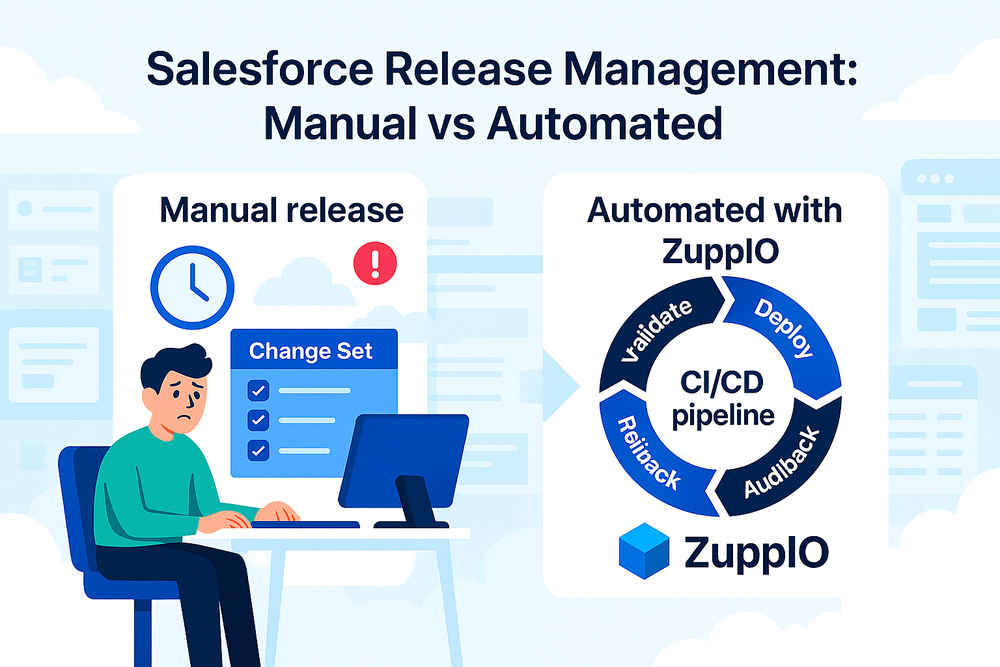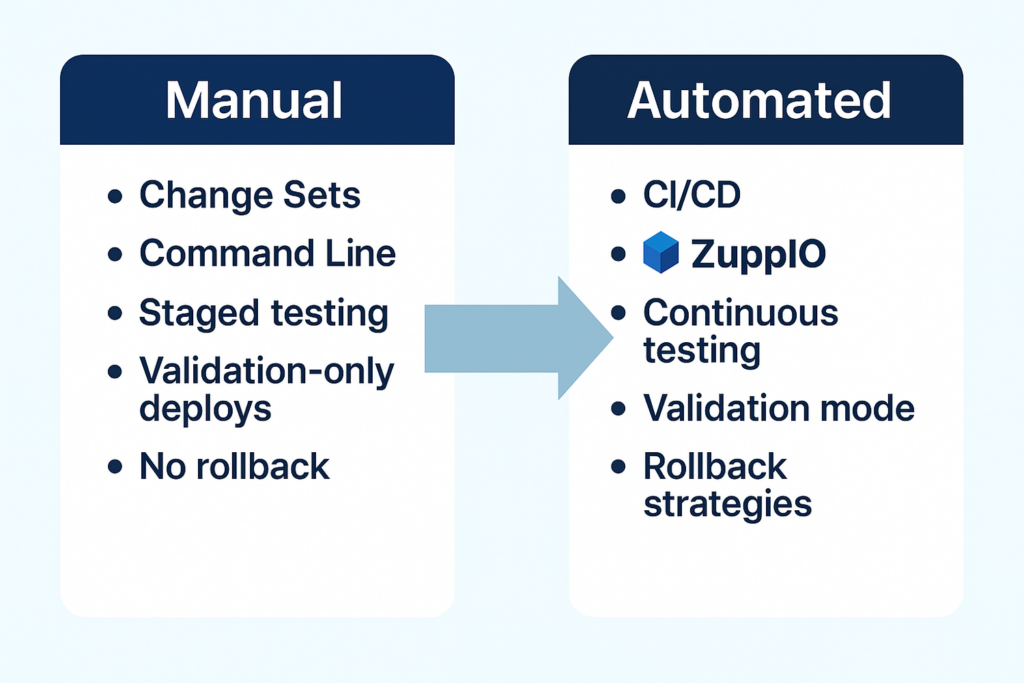Salesforce Release Management Best Practices
Salesforce release management is the process of planning, deploying, and validating metadata changes across sandboxes and production orgs. Best practices include version control, staged testing, validation-only deployments, and rollback strategies. While Change Sets and CLI work for small projects, they don’t scale for enterprises or ISVs. Tools like ZuppIO provide multi-org deployments, centralized logs, and automation with GitHub/Bitbucket integration, making releases faster and safer.

What Is Release Management in Salesforce?
Release management in Salesforce refers to the structured approach for moving changes — metadata, configurations, and customizations — from development to testing environments and finally into production. Unlike ad-hoc deployments, release management ensures that changes are consistent, validated, and aligned with business processes.
Salesforce metadata includes objects, fields, validation rules, page layouts, workflows, Lightning components, and permission sets. Managing these elements requires the metadata API, which provides a programmatic way to retrieve and deploy changes. For example, a developer might use Salesforce CLI or Ant Migration Tool to package updates in XML and move them between orgs.
Effective release management is essential for several reasons:
- Quality control: Ensures changes are tested before reaching end users.
- Compliance: Maintains an audit trail of modifications for regulatory purposes.
- Collaboration: Helps admins, developers, and QA teams work in sync.
- Risk mitigation: Reduces deployment errors that can disrupt user productivity.
In enterprises and ISVs, where multiple sandboxes and production orgs exist, release management is not optional — it’s the backbone of sustainable Salesforce development.
Common Challenges in Salesforce Releases
Despite the variety of tools, Salesforce deployments remain challenging. Teams often face issues that lead to delays, failed deployments, or inconsistencies across orgs.
Typical challenges include:
- Dependency errors: A field is deployed without its parent object, or a validation rule references a missing field. Metadata API requires precise packaging, and a single omission can break the deployment.
- No rollback option: Native Salesforce tools don’t allow reverting a failed deployment. Teams must manually redeploy old versions, which is time-consuming.
- Single-org scope: Change Sets and Salesforce CLI are designed for one-to-one org connections, not mass deployment. ISVs with hundreds of subscriber orgs struggle to maintain consistency.
- Lack of visibility: Logs are distributed across sandboxes and production. Debugging requires piecing together multiple sources.
- Scalability issues: Enterprises with dozens of sandboxes and production orgs cannot scale manual processes without automation.
These pain points highlight why many Salesforce admins and DevOps engineers seek automated solutions that support validation, rollback, and centralized oversight.
Best Practices for Salesforce Release Management
Adopting structured practices reduces risk and improves the reliability of Salesforce releases.
Key best practices include:
- Use version control (Git): All metadata should be stored in repositories like GitHub or Bitbucket. This allows teams to track changes, roll back to earlier versions, and integrate with CI/CD pipelines.
- Stage deployments: Follow a clear path — Development → QA → UAT → Production. This ensures each step is validated before reaching end users.
- Validation-only deployments: Run deployments in validation mode first to confirm dependencies and errors without applying changes. This practice helps avoid runtime failures.
- Rollback strategies: Always prepare scripts or packages to restore previous states. Without rollback, failed deployments can take hours to fix.
- Sandbox testing: Use partial or full sandboxes for regression testing. This ensures compatibility with real data and complex configurations.
- Centralized logs: Collect and store logs from all environments in a single location for auditing and troubleshooting.
Following these principles aligns Salesforce with enterprise DevOps standards and prepares teams for larger-scale challenges.
Why Manual Release Management Is Not Enough
While Change Sets and Salesforce CLI provide baseline functionality, they fall short for enterprises and ISVs.
- Limited scope: Change Sets only work between related orgs (e.g., Sandbox → Production) and require manual component selection. CLI requires technical expertise but still operates at the single-org level.
- No rollback: A failed deployment in Salesforce cannot be undone automatically. This exposes businesses to downtime and user disruption.
- High manual effort: Admins must recreate Change Sets, package XML, or write scripts repeatedly. This increases the risk of human error.
- Inconsistent environments: Subscriber-editable components, such as page layouts or picklists, aren’t automatically updated in managed package upgrades, leaving orgs misaligned.
For ISVs managing hundreds of customer orgs or enterprises running multi-org landscapes, manual processes simply don’t scale. Automation becomes a necessity.
Automating Salesforce Release Management with ZuppIO
ZuppIO addresses the scale and complexity challenges that Salesforce teams face. It extends beyond native tools by enabling automation, multi-org deployments, and robust validation.
Key ZuppIO capabilities include:
- Multi-org deployments: Push metadata changes across dozens or hundreds of orgs simultaneously.
- Validation mode: Test deployments before execution to catch dependency errors early.
- Rollback strategies: Restore previous configurations in case of failure, reducing downtime.
- Centralized logs and audit trails: Full visibility into deployment history for compliance and troubleshooting.
- CI/CD integration: Connect repositories in GitHub or Bitbucket and trigger deployments automatically after commits or merges.
- Post-deploy automation: Run scripts like Anonymous Apex, assign permission sets, or adjust layouts across multiple orgs.
Example: An ISV rolls out a new package version. Subscriber-editable components such as layouts and picklists don’t update automatically. With ZuppIO, the ISV can synchronize these components across all subscriber orgs in a single Job, ensuring consistency and reducing manual work.
With metadata API integration and DevOps-friendly features, ZuppIO elevates Salesforce release management from manual execution to enterprise-grade automation.

Conclusion
Salesforce release management requires careful planning, validation, and structured best practices. While native tools like Change Sets, Ant, and CLI provide a foundation, they are limited in scope and lack rollback or scalability.
For ISVs and enterprises, automation is essential. ZuppIO provides multi-org deployments, validation mode, rollback strategies, centralized logging, and CI/CD integration. By adopting these practices, Salesforce teams can move from fragile manual processes to predictable, scalable, and automated release pipelines.
Release management in Salesforce is the process of planning, testing, and deploying metadata changes (fields, objects, layouts, validation rules) across environments. It ensures consistent quality, reduces risks, and maintains compliance.
What is release management in Salesforce?
Why do Salesforce deployments fail?
Common reasons include dependency errors, missing components, and no rollback options. Manual processes like Change Sets are prone to mistakes. Automation tools like ZuppIO use validation and rollback strategies to minimize failures.
Can Salesforce natively roll back deployments?
No, Salesforce does not provide rollback. Teams must manually redeploy old versions. ZuppIO introduces rollback strategies by validating deployments and enabling safe restoration of previous configurations.
How do ISVs handle subscriber-editable components?
Layouts, picklists, and help texts don’t update automatically in package upgrades. ISVs often need to fix these manually. With ZuppIO, updates can be synchronized across all subscriber orgs in one Job.
How does ZuppIO integrate with CI/CD?
ZuppIO connects with GitHub and Bitbucket. Deployments can be triggered automatically on commits, merges, or releases, enabling DevOps teams to manage Salesforce changes at scale.